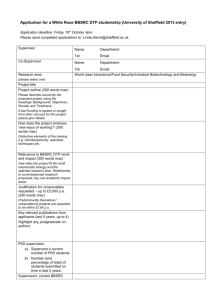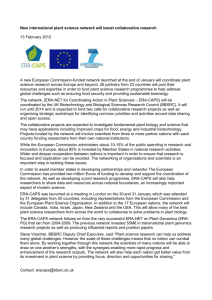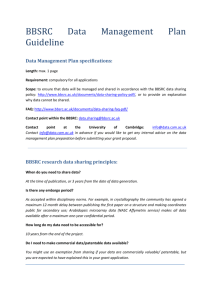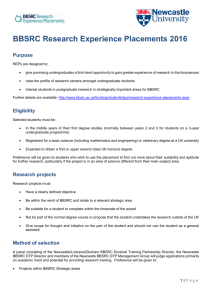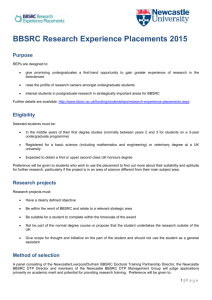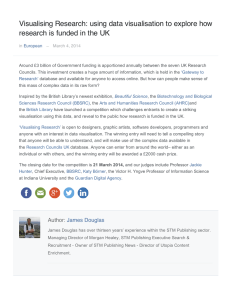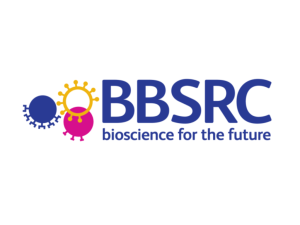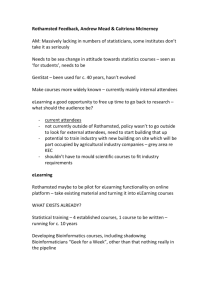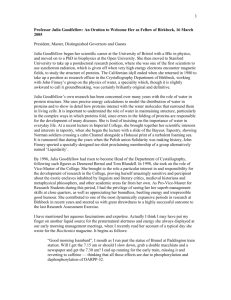BBSRC funding applicants Research Data Service Data Management Planning University of Bristol
advertisement
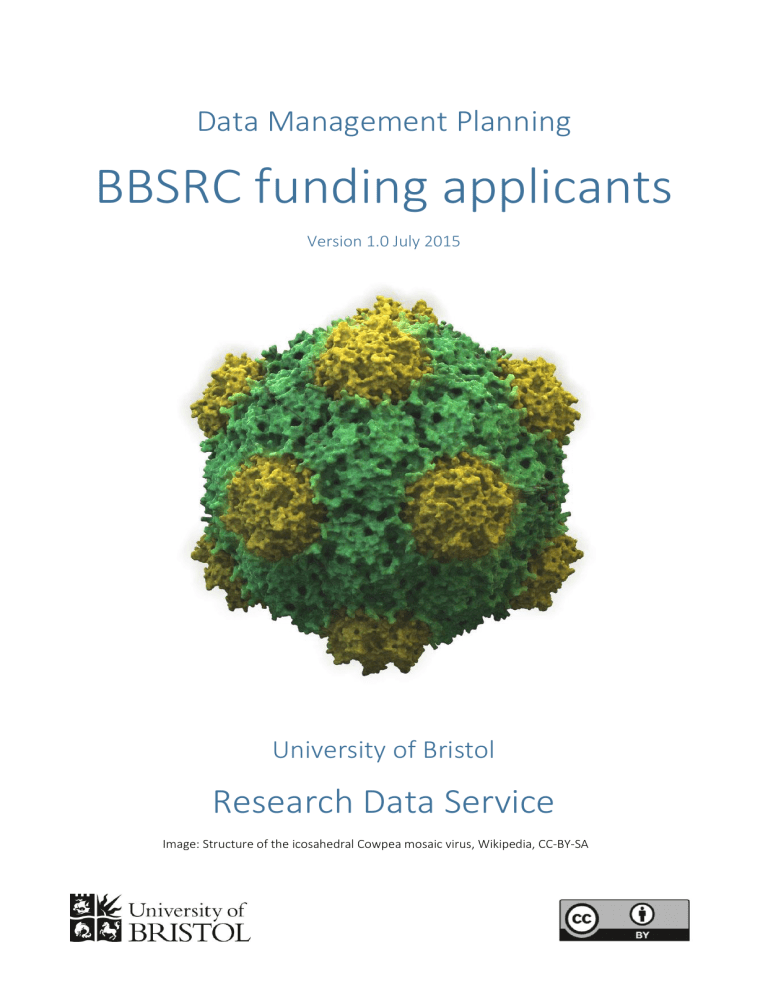
Data Management Planning BBSRC funding applicants Version 1.0 July 2015 University of Bristol Research Data Service Image: Structure of the icosahedral Cowpea mosaic virus, Wikipedia, CC-BY-SA 3.0 maximum extent possible. The re-use of data can lead SUMMARY to new scientific understanding. Data must be released no later than the publication of findings and within three years of Holders of BBSRC grants are encouraged and expected project completion. to follow BBSRC Policy2 in order to practice and Commercial interests should not “unduly delay or promote data sharing and create a scientific culture prevent sharing” of data funded by BBSRC. within which data sharing is embedded. Data must be available for a minimum of ten This guide is intended for BBSRC applicants who are years after project end and in a form appropriate required to submit a Data Sharing Statement along for secondary use. with their application. Sharing via an appropriate, established repository is expected in research areas where such Who does the BBSRC Policy apply to? repositories exist. BBSRC currently supports a Holders of responsive mode research grants must number of resources that are available for the observe the BBSRC data sharing policy. Applicants for bioscience community to use 1. responsive research funding streams should complete Applicants for responsive research funding should a ‘Data Sharing Plan’ as part of their research grant complete a ‘Data Sharing Plan’ as part of their proposal in order to demonstrate a willingness to research grant proposal in order to demonstrate share data. a willingness to share data. Compliance with the BBSRC Data Sharing Policy is The BBSRC Data Sharing Policy does not currently checked by BBSRC as part of the Final Report apply to studentships and fellowships (though it is Assessment at the close of a project. planned to extend it further). BBSRC-funded students Certain data types are considered by the BBSRC and research fellows are instead ‘encouraged to to have an especially high re-use value. consider the policy’ when making applications. Funding to support the management and sharing In the case of responsive mode grant holders, of research data can be requested as part of the compliance is checked by BBSRC as part of the Final full economic cost of a research project. Report Assessment at the close of a project. INTRODUCTION The BBSRC Data Sharing Policy also applies to The Biotechnology and Biological Sciences Research institutions in receipt of core strategic grants and Council (BBSRC) supports the view that publicly- researchers funded by such institutions. The funded research data is a public good, produced in the public interest and should be openly available to the 1 2 http://www.bbsrc.ac.uk/funding/facilities/resources.aspx 2 www.bbsrc.ac.uk/datasharing monitoring of institutional compliance is carried out as Data from high volume experiments part of the Institute Assessment Exercise. Datasets containing hundreds of measurements generated in parallel from a single experimental Exceptions to data sharing sample (for example, omics, sequencing etc.). BBSRC acknowledges that in exceptional circumstances data sharing may not be possible or Low throughput data from long time series or may not be desirable. If you believe this applies to your cumulative approaches research, you should use your Data Sharing Statement as an opportunity to explain why you feel this is the Standardised measurements collected at regular case. You may feel the costs of sharing data with intervals forming a resource that can be subjected to anticipated low re-use would make data sharing not retrospective analysis. Often this type of data is of worthwhile. particularly high value as it cannot be substituted or replaced. Note that only in rare circumstances will BBSRC accept Models generated using systems approaches that ethical considerations preclude the sharing of all the research data you generate. It is far more likely Models created using iterated systems approaches can that some additional actions (such as anonymisation of be as important as the data they generate. They are data and seeking appropriate permissions) may be sharable and re-usable assets with a high re-use required in order to facilitate re-use of the data. potential. Such models should be freely available to any researchers wishing to reproduce experiments. BBSRC recognises the need to protect opportunities for commercialisation of research outputs, but they An appropriate repository in which to deposit models state that commercial interests should not “unduly is the BioModels Database.3 Authors are encouraged delay or prevent sharing” of data funded by BBSRC. to submit models to the BioModels Database before publication of an associated paper (depositors will Research data with a high re-use value receive an identifier that they can use in the Added value can be gained by using certain datasets publication), but models will only be publicly available for purposes other than those for which they were on the BioModels Database once the paper has been originally designed. Researchers in all areas are published. encouraged to consider data sharing where there is scientific merit in doing so. However, the following types of research data are considered by the BBSRC to have a high re-use potential: 3 www.ebi.ac.uk/biomodels-main 3 Costs of sharing research data Data types BBSRC recognises that data sharing has time and cost An estimate of the volume and type of data that you implications. Funding to support the management and expect to generate (e.g. experimental measurements, sharing of research data (for example, staffing and models or images). BBSRC encourages researchers to physical resources such as storage and networking outline all research data and not only that which capability) can be requested as part of the full directly underpins a research publication. economic cost of a research project. Data and metadata standards THE ‘DATA SHARING STATEMENT’ In order to maximise re-use value, BBSRC researchers In order to demonstrate an intention to comply with accepted formats and methodologies. In some the BBSRC Data Sharing Policy, applicants are required disciplines these are well defined; in others, standards to complete a Data Sharing Policy at the time of are still being developed. should generate and manage data using widely application. An additional page of the Case for Support An example of an established standard is the is allocated for this purpose. Using this page for any widespread use of models in SBML and CellML other purpose will result in automatic rejection of the formats. The BioModels Database only accepts models proposal. in these formats in order to help to verify the reproducibility of results. Your Data Sharing Statement will be assessed by peer reviewers separately from the rest of the proposal. Numerous conversion tools exist (such as SBFC), which However, if an inappropriate Data Sharing Statement is will transform models in other formats into SBML or submitted, an applicant’s credibility will suffer. CellML models. If you find you do need to use a non- Proposals with exceptional scientific value but a poor standard technology during the course of your Data Sharing Statement may be offered a conditional research, consider standardising datasets and models award; alternatively, a redrafted Data Sharing prior to sharing them. Statement may be requested. In individual cases, BBSRC reserves the right to take a more prescriptive Where no clear disciplinary guidelines exist concerning approach to data sharing. which formats to use, your own research needs must come first. If you find you do need to use a non- It is suggested that applicants use the following standard format, you should consider converting your headings in their Data Sharing Statement: data to a more widely re-usable format once your own data analysis is complete. If you’re unsure which file formats to use, the UK Data Archive publishes a list of 4 recommended deposit formats.4 These formats may Where no clear disciplinary metadata standards exist, also be appropriate for use throughout your research. it may help to imagine a secondary user attempting to make sense of your output in your absence. If A major barrier to data sharing is the widespread use presented with only the data, they may be faced with of non-standard, highly specialised file formats. In the difficult task of ‘unpicking’ it. So, for example, how order to make use of data, a number of digital would they make sense of file and folder naming technologies must be available, which are known as conventions? Has any special software been used in technological ‘dependencies’. These may be fairly the creation of an output that must also be available in common technologies such as a desktop PC, the order to use it? How was secondary date derived from Windows 7 operating system and Adobe Reader 9 primary data? software. Or the technology required to access data might be rare and hard to acquire, or even unique. You Relationships should address this problem by minimising the number Relationships to any other datasets available for re- of technological dependencies involved in using your use. data as much as possible. Secondary uses Where dependencies are inevitable you should favour ‘open’ technologies rather than proprietary ones. Briefly describe the re-use potential which the dataset Proprietary technologies are owned by a vendor or or model will have once it is complete. group of vendors. Commercial pressures may lead to Data sharing the withdrawal of a particular piece of hardware or software, in favour of a new and possibly incompatible BBSRC recognises two broad approaches to data replacement. In contrast, ‘open’ technologies are sharing: 1) via an established, online public repository supported by a community of users and do not have and 2) by the award holder providing data on request. the same commercial vulnerabilities. A combination of these two approaches may be Metadata is ‘data about data’ or ‘cataloguing appropriate and either of them may be subject to information’ that enables data users to find and/or use specific access mechanisms (such as a requirement to a digital output. In your Statement you should briefly have a data sharing agreement) in order to protect outline plans for documentation, both to meet your confidential or otherwise sensitive data. own needs (i.e. to ensure that you can find what you Sharing via an appropriate, established repository is want, when you need it) and those of later users. expected in research areas where such repositories exist. BBSRC currently supports a number of resources 4 UK Data Archive File Formats Table, www.data-archive.ac.uk/create- manage/format/formats-table 5 that are available for the bioscience community to the funded project, in order to avoid subsequent loss use.5 of staff or motivation. The University of Bristol has its own research data Data sharing timeframe repository which researchers from any discipline may Some communities have established time frames for wish to use. This repository can provide ongoing releasing data (for example, the Crystallography access to research data for extended periods of time Protein Data Bank, where a twelve-month delay and issue unique DOIs for deposited datasets (see between publishing the first paper on a structure and ‘Citing research data in research outputs’, below). For making co-ordinates public for secondary use is smaller datasets, there is no cost. If you are planning typical, or Metabolomics (MeT-RO) where a six-month to deposit larger datasets with the repository, a cost delay in publication can be requested). It is the may be incurred. Contact the data.bris service6 as early responsibility of the applicant to reference such as possible if you believe you’ll need to make use of disciplinary guidelines in the Data Sharing Statement. Bristol’s data repository. Where no clear community guidelines exist, BBSRC Note that the responsibility for ensuring data is expects data to be released no later than the retained remains with the grant holder even when publication of findings and within three years of data is deposited with an external archive for sharing project completion. purposes. Therefore BBSRC recommends that a copy is retained locally for security purposes. Primary data should be securely retained, in an accessible format, for a minimum of ten years after Researchers have the option of providing data directly project completion. to third parties on request. However, researchers choosing to do so should consider the BBSRC Proprietary data requirement to make data available for a minimum of ten years after the project ends, in a format Specify any data which will not be freely available for appropriate for secondary use. Some updating of both re-use and a brief explanation of why this is the case. data formats and accompanying metadata is to be For example a co-funder may have requirements expected during this period. which conflict with those of the BBSRC. BBSRC suggests that any data preparation which is Format/s required before sharing (such as standardisation or List of the formats of final datasets or models (see quality checking) should be done within the lifetime of Data and metadata standards, above). 5 6 The University of Bristol’s Research Data service data.bris, data.bris.ac.uk http://www.bbsrc.ac.uk/funding/facilities/resources.aspx 6 ________________________________________ CITING RESEARCH DATA IN RESEARCH OUTPUTS From 1st April 2013 all the UK’s research funding councils, as part of RCUK, require research outputs (i.e. journal articles) to provide a means by which third parties can access any underpinning research datasets. This may be a reference (such as a unique URL or DOI) printed in a paper, which will lead an enquirer to a specific web page where the data is available. Or the enquirer might be directed to a page which displays the contact details of a custodian of the data, whom they are asked to email in order to gain access to the data. Given the extended timescales involved in this process (possibly extending beyond the mandatory three years mentioned above), it is strongly recommended that the authors of published academic outputs do not provide their current contact details as a means of accessing underpinning research data, as these details will change over time. If you plan to use an established data repository service, ask this service for a unique reference identifier which could be included in the publication instead. If you’re not planning to use an established data repository service, contact data.bris7 for further guidance. 7 The University of Bristol’s Research Data service data.bris, data.bris.ac.uk 7 SAMPLE BBSRC DATA SHARING STATEMENT The following is intended as an illustration of a BBSRC Data Sharing Statement. It is drawn from a real world BBSRC proposal prepared by the School of Biological Sciences and submitted to the BBSRC. The plan is made public with the kind permission of the applicant, Dr Christos Ioannou. Full details of experiments and costing were covered in the wider ‘Case for Support’. This document is not available. The following paragraph explains the general purpose and nature of the project: This project is interested in how differences between individuals in groups affects both group-level outcomes (such as decision making) and individual-level outcomes (such as the time available for an animal to feed in a particular place). The project is entirely lab based, with High Definition video being used to record fish shoals from above. From this video, the position of each fish is tracked using video-tracking software, and the resulting data are time series of fish coordinates. These coordinate data provide a high temporal and spatial resolution to answer the hypotheses of interest. DATA SHARING STATEMENT Data types: In each of the experiments outlined in the Case for Support, there will be generated a time series of coordinate data for fish positions in each trial. This primary data is not of the volume obtained in high-volume experiments (such as sequencing) or long time series data; access will be provided to encourage reuse whether the trials form part of a published article or not. In our analyses, from this primary data group-level properties and/or summary statistics over the time series will be calculated. However, providing the data in the raw format of coordinate data along with metadata will allow for the most diverse range of possible uses. From previous work, we estimate the data files to be less than 1TB over the course of the study. Still images and video will be kept locally on multiple external hard drives for data analysis and verification, and will be backed-up where possible with the remainder of the 5TB each PI is provided with free of charge by Bristol’s Research Data Storage Facility. The University of Bristol Research Data Storage Facility (RDSF) provides secure, long-term storage, exclusively for research data. This £2m investment provides nightly backup of all data, with further resilience provided by three geographically distinct storage locations. A tape library is used for backup purposes and also for long-term offline data storage. The RDSF is managed by Bristol’s Advanced Computing Research Centre (ACRC) which has a dedicated steering group and a rigorous data storage policy (https://www.acrc.bris.ac.uk/acrc/RDSF_policy.pdf). Data formats and metadata standards: To facilitate the most widespread reuse, data will be provided in text (.txt) and comma delimited (.csv) formats. Metadata will accompany these data to explain what hypotheses the data were originally designed to test, how the data were collected and who collected the data, where and when. In cases where data is processed, for example by calculating average turning angle by the fish, a full description of the procedure used will be given. Secondary uses: Our project is strongly focused on analysis of empirical data. However, a strength of recent work in collective behaviour is the synergy between theoretical and empirical work, thus our data will be provide a rich data set in inspiring modelling beyond the scope of the proposed work, provide model parameters for more realistic models, and provide data to test model predictions against. Analytic tools developed in the future can also be tested using the data provided from this study. Data sharing: All data generated during the project will be made freely available via the University of Bristol’s Research Data Repository. DOIs to these data will be provided (as part of the DataCite programme) and cited in any published articles using this data and any other data generated in the project (to allow data unrelated to any published work to be found). Data deposited into Bristol’s Research Data Repository will be maintained for a minimum of 20 years. There are no security, licensing or ethical issues related to the expected data, and all data used in the project will be generated directly as a result of the project, without any pre-existing data being used. Data sharing timeframe: Any data relevant to a published article will be made available alongside the article when published. All other data will be made available within three-years of the project completion; the PI, CCI, will take responsibility to ensure that this is carried out after the PDRAs have finished. 9
